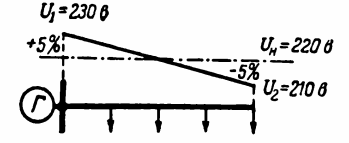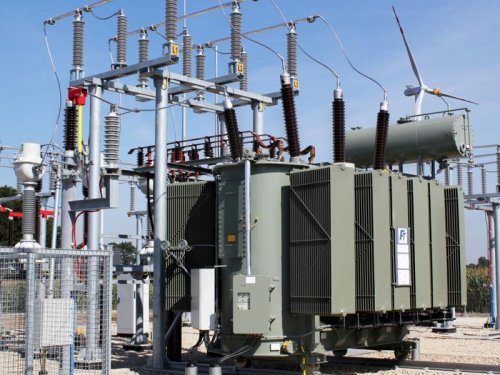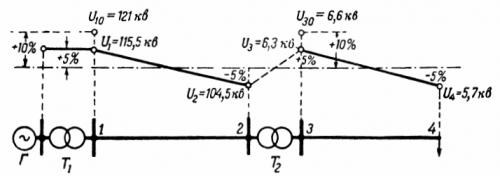Rated voltages of generators and transformers
The nominal voltage of generators and transformers is the voltage for which they are designed for normal operation and give the greatest economic effect.
Each electrical network is characterized by the nominal voltage of the electricity receivers that are powered by it. The primary windings of transformers also belong to the receivers of electricity. In reality the voltages at the terminals of the receivers will deviate from the nominal because there is no grid due to voltage drop its wires do not have the same voltage at all points. To reduce these voltage deviations, it is desirable to have an overvoltage at the beginning of the line at the source, and at the termination point to reduce it from nominal.
The permissible voltage deviations depend on the nature of the receivers and the purpose of the network. For the most part, a tolerance of + 5% is considered acceptable.Therefore, the nominal voltage of the generators is taken as a voltage 5% higher than the nominal voltage of the network, taking into account the presence of voltage loss in it. For example, with a nominal network voltage of 6 kV, the nominal voltage of the generators will be 6.3 kV.

Rice. 1. Nominal mains voltage
The presence of nominal voltages of the secondary and primary windings of the transformers is determined by considering a circuit consisting of a generator G with a step-up transformer T1 on an overvoltage of power line 1-2 (for example, 110 kV), a step-down transformer T2 and one of the lines 3- 4, starting from the buses for reduced voltage. voltage (for example, 6 kV) step-down transformer T2.
A horizontal dashed line represents the nominal voltage as a percentage of the individual network sections. For section 1-2, nominal network voltage Un = 110 sq., and for a plot of 3-4 Un = 6 sq. The connection of these nominal network voltages through transformation factorequal to the ratio of the rated voltages of the networks of sections 1-2 and 3-4, the line of rated voltages can be given in the form of a straight line, as shown in Figure 2.
Rice. 2. Voltage at individual power transmission points
The secondary winding of the transformer T2 is a generating winding for line 3-4, and therefore its voltage at the load of the transformer must be 5% higher than the rated voltage of the network, that is, it must be 6.3 kV.But since there is a voltage loss in the transformer on load, to obtain a voltage on the secondary side of the transformer 5% higher than the rated line voltage, the open circuit voltage of the transformer must be about 10% higher than nominal mains voltage, which gives 6.6 kV …
Similar phenomena occur in row 1-2 of the highest voltage. The open-circuit voltage of the transformer, that is, the rated voltage of the secondary winding of the step-up transformer, which is also the generating winding for line 1-2, must be 10% higher than the rated voltage of that line. The corresponding no-load and load voltages are shown in the circuit diagram.
Considering the above, the standard accepts the nominal voltages of the secondary windings of transformers: 6.6; 11.0; 38.5; 121; 242, 347, 525, 787 kV. For short lines of local networks, the nominal voltages of the secondary windings are accepted only for the corresponding nominal network voltages of 6.3 and 10.5 kV.
The nominal voltage of the primary windings of the transformer, which are receivers of electricity, according to what was said above, must be equal to the nominal voltage of the network, i.e. 6, 10, 35, 110, 220, 330, 500 and 750 kV.
For the primary windings of transformers connected directly to the busbars of a station or substation or to the terminals of generators, the standard provides for voltages 5% higher than the nominal voltage of the network, namely: 3.15 and 10.5 kV.
Rice. 3. Voltage of primary and secondary windings of transformers
In fig.3 shows examples of installations where, at a nominal voltage of 6 kV, the voltages of the windings in the transformers are chosen to be +5 or + 10% higher than the nominal voltage of the network.



